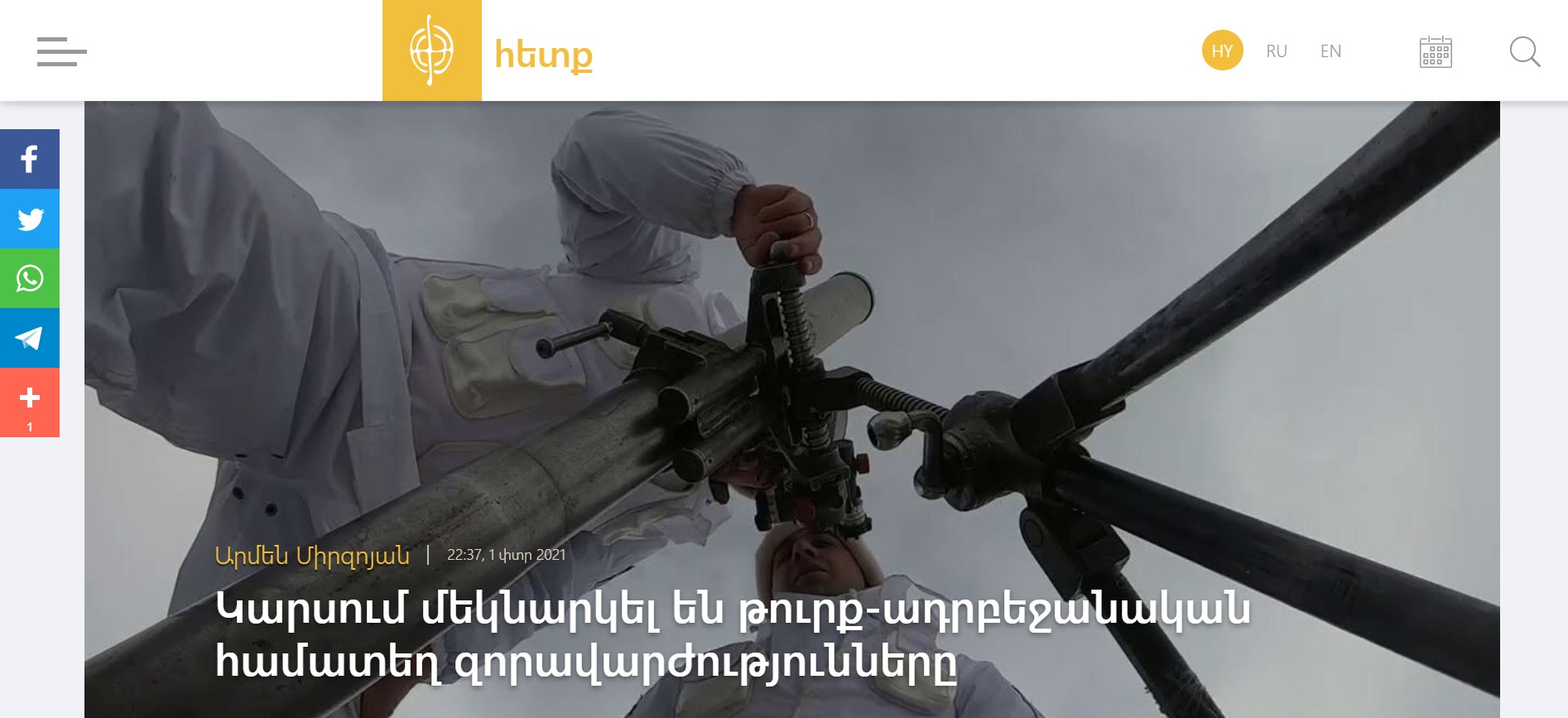
The most discussed topics in the Armenian media in February 2021 were the Turkish-Azerbaijani joint military exercises in Kars, discussions on the use of the Russian Iskander in the recent Artsakh war, and the destruction of Armenian historical and cultural values by Azerbaijanis.
Exercises: dangers and expectations

From February 1 to 12, joint Turkish-Azerbaijani military exercises called “Winter 2021” were held in Kars, which were interpreted as not being accidental.
On Channel 5, military expert Van Hambardzumyan said that the Turks’ eye is on Syunik, and that eye can be frightened if there are joint Armenian-Russian military exercises first in Syunik, then on the border with Nakhichevan, in the Gyumri section.
He thinks that no military exercises are done just like for the sake of it, and he expanded that in the current situation, the probability of war is high․ “The RA Armed Forces have suffered great losses, there is a serious internal political crisis in Armenia, and a government that is unable to control the current situation. This means that there are favorable conditions, which would be a sin not to use.”
During the same program, the host said that Turkey is showing its teeth to Russia through the Kars military exercises.
“News.am” published the military commentator of the Russian “Gazeta.Ru” Mikhail Khodaryonok’s article, “Turkey teaches Azerbaijan to fight: How the balance of power in Karabakh has changed,” which refers to the military exercises held in Kars.
“The Turkish-Azerbaijani military exercises that were initially not so interesting have become interesting. Another more important question is how the military-political situation will develop in this explosive region in the near future.”
The Russian “Iskander:” from endangered Armenian-Russian relations to the use of ineffective weapons
The topics of the military exercises and the Russian “Iskander” became the subject of heated discussions and criticism, moreover, in the case of “Iskander,” the criticism of the Prime Minister was voiced not only from Armenia but also from Russia.
The media actively covered the remote “debate” between the RA Prime Minister Nikol Pashinyan and the third RA President Serzh Sargsyan on that topic.
In an interview with ArmNews TV, Serzh Sargsyan said that the Iskander should have been used on the fourth or fifth day of the war, but according to his reliable information, it was used in the last period of the war, and more specifically in the direction of Shushi.
Then, Nikol Pashinyan answered, “And, maybe, they will answer, why the ‘Iskander’ that fired did not explode or exploded by ten percent, for example.”
Pashinyan’s statement provoked a new wave of criticism and also became a cause of mockery among representatives of the military sphere.
On Channel 5, Tigran Abrahamyan, a former adviser to the Artsakh President, expressed the opinion that “the statement about Iskander is a blow to the Armenian-Russian relations, and Nikol Pashinyan entered this game purposefully. Some forces in the West are already trying to play with this situation, and in these conditions Nikol Pashinyan thinks that he can maneuver and get what he wants, first of all, maintaining his power, realizing that all this is done at the expense of Armenia and Artsakh.”
“ArmNews” host Abraham Gasparyan also thinks that Pashinyan’s statement is an aggravation of relations with a strategic ally, “Let no one think that the one who serves the interests of Turkey and Azerbaijan, who handed over Artsakh, will just make anti-Russian statements.”
“The attempt to discredit one of the best weapons of a friendly state is described by Russian experts and publicists as a clumsy implementation of a direct order received from Soros,” said the author of the report on the Russian response to Iskander.
On the same topic, “Aysor.am” reproduced the publication of “Комсомольская правда,” in which Vladimir Kovalev, Doctor of Technical Sciences, an engineer with 37 years of experience in tactical missile design, said, “Announcing the inefficiency of the Russian Iskander missiles, Pashinyan, as they say, should be responsible for a ‘brawl.’ “Making such serious demands on the missile system and at the same time publicly admitting that he ‘does not know’ the essence of the issue, it is unworthy and even disgraceful for the Prime Minister of Armenia.”

“What does it mean that the rocket exploded by 10%, as a rocket either explodes or does not,” he told 168.am. Moscow Political and Military Alexander Khramchikhin, Deputy Director of the Center for Analysis, military expert, expressed his surprise at Nikol Pashinyan’s observations on the unsuccessful use of the Russian “Iskander” system in the Artsakh war.
Alexander Khramchikhin questioned Nikol Pashinyan’s claims on this topic. According to Khramchikhin, a missile may not explode for one reason or another, as is the case of any weapon, as the equipment has the ability to cause problems, but in general, it is interesting where the pieces of that missile are, because Azerbaijan would be happy to show those pieces, and why hasn’t it? It is very strange.
Endangered and destroyed Armenian historical and cultural values
One of the topics circulating in February is the destruction of Armenian historical and cultural values by the Azerbaijanis, as well as the attempts to attribute those values to them. Tigranakert of Artsakh was in the center of attention.
Public TV has referred to this very topic in several of its February programs. In one of the programs, the host describes Azerbaijan’s steps as follows: “Azerbaijan is trying to make someone else’s, in this case, ours, their own, thanks to the hangups of not having its own history. After considering the Armenian churches as Udi, Baku claims that they discovered Tigranakert in Artsakh, founded by Tigran the Great. Unfortunately, the archeological site is under their control today, but the findings obtained by Armenian archeologists are with us.”
In one of the publications of “Lragir.am” Hamlet Petrosyan, the leader of the Tigranakert excavation expedition, responding to another slander from Baku noted that the archeological findings of the Tigranakert excavations are the property of the people of Artsakh.
“Artsakh’s non-political recognition does not deprive its native people of their right to culture. Including the right to explore and popularize cultural heritage. So, the archeological research of Tigranakert was carried out on an absolutely legal basis.”
One of Public TV’s reports titled “Vandals of the 21st Century,” states that after the establishment of the ceasefire in Artsakh, Azerbaijan started fighting against Armenian cultural values, trying to destroy the Armenian trace deep in Artsakh by presenting the bombing of the church, the breaking and damaging of khachkars, monuments and tombstones, etc. “This crime against culture is sponsored at the highest level, as evidenced by the fact that months after the war, Aliyev and his family visited Shushi and erected statues of some Azerbaijani figures on the site of Vazgen Sargsyan’s statue.”
On an “ArmNews” broadcast, Abraham Gasparyan spoke about the sale of Armenian churches in the Turkish real estate market.
“Two churches are sold separately for 6 million liras; they are not to be exchanged. Needless to say, it is in line with Turkish handwriting. “No average Armenian statistician needs to hear a lecture on the essence of the Turk, his value system, perceptions of human relations,” he said.
“1in.am” also republished a “Zhamanak” article entitled “Azerbaijani vandalism for the highway leading to Shushi”: “Azerbaijani authorities have completely demolished and leveled the cemetery of Taghlar village in the Hadrut region of the Artsakh Republic. According to eyewitnesses, the road to Shushi will pass through that area.”
On an Armenian Public Radio broadcast, Arthur Gevorgyan, director of the National Park Museum of Sculpture, noted that what really happened was ordinary cultural fascism, not the attitude of individuals and their soldiers towards the Armenian reality and culture, but a campaign prepared by the state apparatus.
According to the author, it is enough to be Armenian in Azerbaijan for values to be violated.
And here is the announcement of the National Academy of Sciences on organizing the monitoring of the cultural heritage of the territories passed to Azerbaijan in “Armtimes.com.”
Over the past century, the Azerbaijani leadership, which has “succeeded” in the practices of assimilation, ethnic cleansing, and recurring massacres of indigenous peoples in the region, has made the policy of falsifying the region’s history, destroying Armenian cultural heritage, or “Albanianizing” a national goal.
In a statement, the National Academy of Sciences of the Republic of Armenia asked the leaders of the Minsk Group Co-Chair countries to assist the United Nations Educational, Scientific and Cultural Organization (UNESCO) in monitoring the assessment of cultural heritage in the area of hostilities.
Anahit Danielyan


Add new comment
Comments by Media.am readers become public after moderation. We urge our readers not to leave anonymous comments. It’s always nice to know with whom one is speaking.
We do not publish comments that contain profanities, non-normative lexicon, personal attacks or threats. We do not publish comments that spread hate.